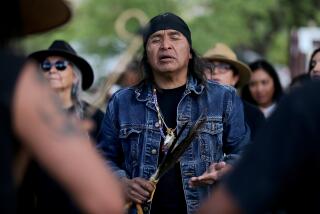Environmentalists Assail Plan to Mine in Forest Area
LOS PADRES NATIONAL FOREST — A mining company is digging for clay this week in a remote and protected wilderness deep in Los Padres National Forest--a move that outrages environmentalists.
Glendale-based Pacific Custom Materials Inc. seeks to explore seven of its claims adjacent to the Sespe Wilderness Area, 15 miles north of Ojai. Heavy equipment is in place, signs are being posted and the work will begin by week’s end, a company spokesman said.
Although the initial forays will cause little disturbance to the land, the activity presages the company’s attempt to win permission for full-scale mining inside the northern edge of the wilderness close to Lockwood Valley.
The company must pass environmental reviews before that work can begin, and officials plan to repair land damaged by the mining. But environmentalists say the work would deeply scar the landscape and they vow to resist the plan.
“A matter of principle is at stake. It’s anathema to see wilderness passed from federal ownership,” said John Buse, director of the Environmental Defense Center in Ventura.
But company officials say they have a legal right to explore their mineral claims, which were in place before Congress designated the wilderness area. The clay is needed for products ranging from fireproof roof tiles to skid-resistant highway surfaces to lightweight concrete used in high-rise buildings.
Pacific Custom Materials is a subsidiary of Texas Industries Inc. of Dallas, or TXI, which employs 4,100 people and is one of the nation’s biggest suppliers of construction materials and steel. The corporation’s annual sales total $1.2 billion.
In a prepared statement, Bill Rapier, corporate reserves manager, said, “TXI can provide quality building materials, jobs and tax revenue to Ventura County while protecting the environment.”
At stake are 23 mining claims spanning 460 acres in and around the Sespe Wilderness Area, which stretches from the Golden State Freeway to California 33.
The Sespe wilderness is a vast and untrammeled territory of forested peaks, deep canyons and flowing streams, including Sespe Creek. The area is so pristine Congress afforded it the highest level of protection by designating it wilderness in 1993, largely to safeguard the wild and scenic stream.
The 1964 Wilderness Act established a network of wild lands that provide opportunities for solitude and primitive recreation. Roads, vehicles, aircraft and buildings are typically prohibited.
But valid mining claims that predate the wilderness act can be pursued by companies, even in protected areas, under the nation’s 126-year-old mining law, which Congress passed to open the West for expansion. To develop those claims, a company must prove minerals are present and can be removed and sold at a reasonable profit.
In a first step down that path, Pacific Custom Materials intends to collect samples of clay from seven representative claims. The work involves removing 50 tons of soil from each of the seven sites and using a backhoe and dump trucks. The sample collection will leave a disturbed area of about 100 feet across at each site, which will be repaired when the job is done, said Mark D. Radke, district ranger for Mt. Pinos forest district. Forest Service officials are overseeing the work.
If sufficient clay is found, the company can request patents, which allow it to transfer the land on all 23 claims from public to private ownership. Cost per acre in the transaction: $2.50, the amount established in the 1872 mining act.
Environmentalists worry the mining will wreck the wilderness.
“It’s a big issue of concern,” said Norbert Reiddy, spokesman for the Wilderness Society. “Mining is a hard thing to control on any public land, especially . . . in or on a boundary of a wilderness area. It’s a problem and always brings a lot of focus.”
“We’re going to be creating islands of biological disruption in a sea of wilderness,” said Buse of the Environmental Defense Center. “It will destroy ecological functions and spoil its character.”
In an Aug. 27 letter, Radke said no sensitive plants or animals were found in the area of the mining claims. He added that the mining proposal has to clear environmental reviews under state and federal law and also comply with county land-use ordinances.
Jim Evans, senior technical minerals specialist for the U.S. Bureau of Land Management, said the company faces numerous obstacles along the way to approval of mining patents. A final decision, he said, could take years.
For example, the mining plan must pass muster with BLM, the Forest Service and Ventura County. Next, the application must be sent to Washington for review by the secretary of the Interior.
“This process is not simple and it’s even more difficult with new regulations” imposed under the Clinton administration, Evans said.
More to Read
Sign up for Essential California
The most important California stories and recommendations in your inbox every morning.
You may occasionally receive promotional content from the Los Angeles Times.










